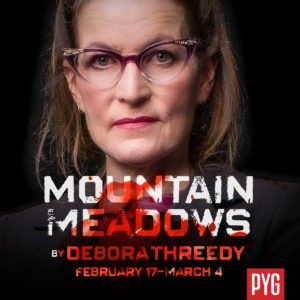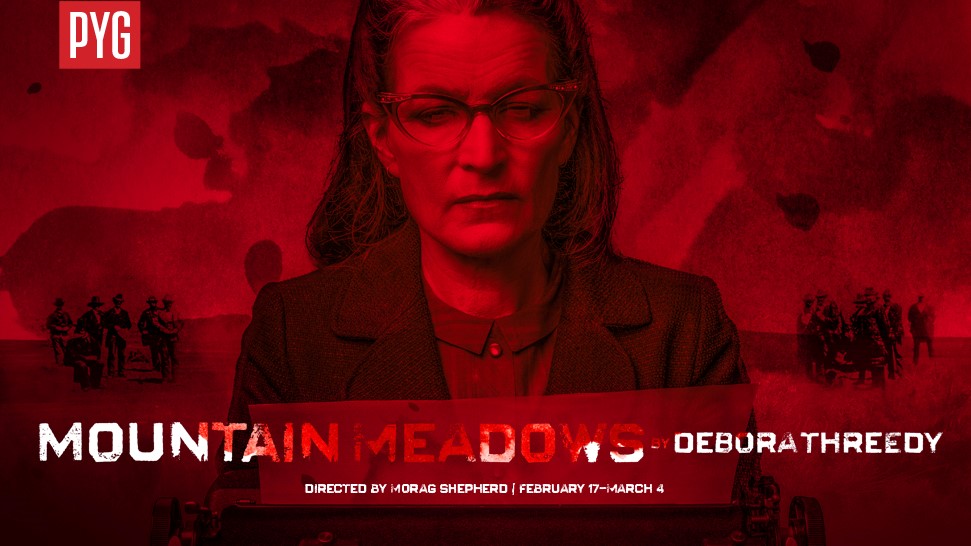SALT LAKE CITY — PYGmalion Productions’s Mountain Meadows tells the story of two women linked by tragedy and their longing for truth and resolution. With the increase in efforts to erase, undermine or deny some of the more controversial aspects of American history, the timing of Mountain Meadows could not be more relevant.

Written by Debora Threedy, Mountain Meadows alternates storylines between Nita Brooks and Miranda. Inspired by real American historian Juanita Brooks, Nita, played by Stephanie Howell, is a schoolteacher and historian living in Southern Utah. One day, she is summoned by Nephi Johnson, played by David Hanson, who, while close to death, wants to share his knowledge of the Mountain Meadows Massacre – the violent attack perpetrated by Mormon settlers that took the lives of 120 men, women, and children who were traveling by wagon train bound for California. Nephi dies before Nita can document the experience, however his spirit visits and encourages her to uncover the full truth. Despite her passion for the truth, Nita is met with obstacles from her sister Charity, played by Tiffani DiGregorio, community members and church leaders who all believe the past should remain in the past.
Miranda, played by Carlie Young, living years before Nita, learns that she was a witness to and survivor of the attack who was ultimately raised by a Mormon family when both of her parents were killed. This revelation, which comes after the death of her assumed mother, leaves Miranda grappling for the truth about her birth parents and the role, if any, her new family, Samuel, played by David Hanson, Saphrona, played by Daisy Blake Perry and Jeremy, played by Matthew Ivan Bennett, had in their demise.
Morag Shepherd masterfully directed this superb ensemble which easily enabled one to consider a variety of perspectives. Is uncovering the truth worth soiling the reputation of otherwise good people? Is it worth eternal consequences that could effect other family members? Is it worth the reputation of an entire church? One scene with Blake and Young was particularly moving. Saphrona is reminiscing about her life and home before moving out west. She tearfully tells Miranda how it felt to be given only 30 minutes to collect her children and belongings before her house was burned by an angry mob. This expression allows one to consider if the Mormon settlers’ behavior was somehow justified due to previous persecution. I applaud Threedy’s thought-provoking script and Shepherd’s direction that gave ear to such reflections.
Howell gave a commanding performance. Her passionate delivery was seamless and allowed one to appreciate Nita’s desire for truth. Howell’s scenes with Hanson were especially moving, and their delivery felt natural and effortless. The inclusion of Nephi’s ghost allowed Nita to express herself without having to justify the importance of her work, which she must do in nearly all her interactions with others. Howell’s expressions of frustration and angst allowed one to not only understand the lengths to which people went to deny or hide the massacre, but also the risks involved with continuing her research.
Young brought a youthful, almost an innocence to the stage as Miranda. She portrayed well what it must feel like to be thrust into an unexpected journey of self-discovery. Miranda asked the difficult questions in her attempt to understand her heritage. Her character felt grounding or like a foundation: yes, we can listen to the expressions of others, but ultimately we must admit that nothing excuses what transpired that day. I appreciated that she never wavered from her convictions that right is right and wrong is wrong.
The quality of work by stage manager Jennie Pett and the entire production staff for Mountain Meadows cannot be overstated. Allen Smith’s set design allowed one to easily comprehend the alternating timelines with the use of a large grass covered platform for the scenes with the early Saints and simple props like an ironing board and typewriter indicating more modern times. In addition, costume design by Andrea Davenport helped bring alive each time period and also aided visually to the passage of time particularly with Howell’s appearance.
Much adoration to soundscape designer Mikal Troy Klee and light designer Pilar I for their impeccable execution. One compelling scene is when Samuel is recalling the massacre to Miranda. While Hanson’s delivery is impactful, it is only when it is complimented with the sounds of gun shots and a bold red light projected behind him that the magnitude of the carnage can truly be understood. Another noteworthy scene is Nita working at her typewriter. The lights are dim and music is accompanying the sound of keystrokes. These scenes are only a few examples of the beauty and impact the technical aspects can have while working in conjunction with those on stage. And the collision of talent was breathtaking.
Mountain Meadows is a must-see experience that fairly examines a dark stain on Utah’s history that is too often forgotten or misunderstood. Utahns should be grateful to Juanita Brooks for her efforts in researching and preserving the memory of the Mountain Meadows Massacre. Her work serves as a reminder that withholding the truth does not change the past, confusing fact from fiction will only lead to more confusion, and embracing all aspects of our history will ultimately empower us to improve our future.
[box]PYGmalion Productions’s Mountain Meadows plays at Rose Wagner Center for the Performing Arts February 17-March 4, 2023, Thursdays and Fridays at 7:30 PM, Saturdays at 4:00 PM, and Sundays at 2:00 PM. Tickets are $17.50 -$22.50. For more information, visit http://pygmalionproductions.org/.[/box]
